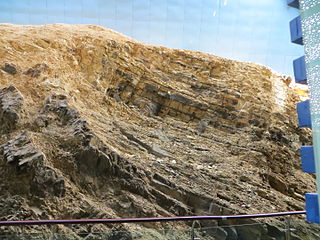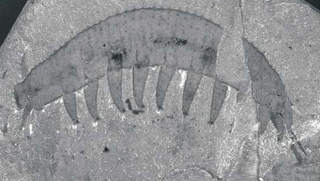
The Burgess Shale is a fossil-bearing deposit exposed in the Canadian Rockies of British Columbia, Canada. It is famous for the exceptional preservation of the soft parts of its fossils. At 508 million years old, it is one of the earliest fossil beds containing soft-part imprints.

Hallucigenia is a genus of lobopodian, known from Cambrian aged fossils in Burgess Shale-type deposits in Canada and China, and from isolated spines around the world. The generic name reflects the type species' unusual appearance and eccentric history of study; when it was erected as a genus, H. sparsa was reconstructed as an enigmatic animal upside down and back to front. Lobopodians are a grade of Paleozoic panarthropods from which the velvet worms, water bears, and arthropods arose.

The Maotianshan Shales (帽天山页岩) are a series of Early Cambrian sedimentary deposits in the Chiungchussu Formation, famous for their Konservat Lagerstätten, deposits known for the exceptional preservation of fossilized organisms or traces. The Maotianshan Shales form one of some forty Cambrian fossil locations worldwide exhibiting exquisite preservation of rarely preserved, non-mineralized soft tissue, comparable to the fossils of the Burgess Shale of British Columbia, Canada. They take their name from Maotianshan Hill in Chengjiang County, Yunnan Province, China.

Opabinia regalis is an extinct, stem group arthropod found in the Middle Cambrian Burgess Shale Lagerstätte of British Columbia. Opabinia was a soft-bodied animal, measuring up to 7 cm in body length, and its segmented trunk had flaps along the sides and a fan-shaped tail. The head shows unusual features: five eyes, a mouth under the head and facing backwards, and a clawed proboscis that probably passed food to the mouth. Opabinia probably lived on the seafloor, using the proboscis to seek out small, soft food. Fewer than twenty good specimens have been described; 3 specimens of Opabinia are known from the Greater Phyllopod bed, where they constitute less than 0.1% of the community.

Marrella is an extinct genus of marrellomorph arthropod known from the Middle Cambrian of North America and Asia. It is the most common animal represented in the Burgess Shale of British Columbia, Canada, with tens of thousands of specimens collected. Much rarer remains are also known from deposits in China.

Aysheaia is an extinct genus of soft-bodied lobopodian, known from the Middle Cambrian Burgess Shale of British Columbia, Canada

Sidneyia is an extinct arthropod known from fossils found from the Early to the Mid Cambrian of China and the Mid Cambrian Burgess Shale of British Columbia, Canada.

Ottoia is a stem-group archaeopriapulid worm known from Cambrian fossils. Although priapulid-like worms from various Cambrian deposits are often referred to Ottoia on spurious grounds, the only clear Ottoia macrofossils come from the Burgess Shale of British Columbia, which was deposited 508 million years ago. Microfossils extend the record of Ottoia throughout the Western Canada Sedimentary Basin, from the mid- to late- Cambrian. A few fossil finds are also known from China.

Anomalocaris is an extinct genus of radiodont, an order of early-diverging stem-group arthropods.

Waptia is an extinct genus of arthropod from the Middle Cambrian of North America. It grew to a length of 6.65 cm (3 in), and had a large bivalved carapace and a segmented body terminating into a pair of tail flaps. It was an active swimmer and likely a predator of soft-bodied prey. It is also one of the oldest animals with direct evidence of brood care. Waptia fieldensis is the only species classified under the genus Waptia, and is known from the Burgess Shale Lagerstätte of British Columbia, Canada. Specimens of Waptia are also known from the Spence Shale of Utah, United States.

Naraoia is a genus of small to average size marine arthropods within the family Naraoiidae, that lived from the early Cambrian to the late Silurian period. The species are characterized by a large alimentary system and sideways oriented antennas.
The Burgess Shale of British Columbia is famous for its exceptional preservation of mid-Cambrian organisms. Around 69 other sites have been discovered of a similar age, with soft tissues preserved in a similar, though not identical, fashion. Additional sites with a similar form of preservation are known from the Ediacaran and Ordovician periods.
A number of assemblages bear fossil assemblages similar in character to that of the Burgess Shale. While many are also preserved in a similar fashion to the Burgess Shale, the term "Burgess Shale-type fauna" covers assemblages based on taxonomic criteria only.

Marrellomorpha are an extinct group of arthropods known from the Cambrian to the Early Devonian. They lacked mineralised hard parts, so are only known from areas of exceptional preservation, limiting their fossil distribution. The best known member is Marrella, with thousands of specimens found in the Cambrian aged Burgess Shale of Canada. The group is divided up into two major orders, Marrellida and Acercostraca. Marrellida is recognised by the possession of head shields with two or three pairs of elongate spine-like projections, and three pairs of uniramous appendages on the cephalon, while Acercostraca generally have large ovoid carapaces that cover the entire upper half of the body, and five pairs of uniramous cephalic appendages. Both groups have unbranched antennules and a segmented trunk with biramous appendages. Recent research has suggested the previously enigmatic Cambrian trilobite-like arthropods Skania and Primicaris belong to this group. Their phylogenetic position is uncertain, various studies have alternatively placed them in the Arachnomorpha as relatives of Artiopoda, as related to Mandibulata, or as stem group euarthropods.
The fossils of the Burgess Shale, like the Burgess Shale itself, are fossils that formed around 505 million years ago in the mid-Cambrian period. They were discovered in Canada in 1886, and Charles Doolittle Walcott collected over 65,000 specimens in a series of field trips up to the alpine site from 1909 to 1924. After a period of neglect from the 1930s to the early 1960s, new excavations and re-examinations of Walcott's collection continue to reveal new species, and statistical analysis suggests that additional discoveries will continue for the foreseeable future. Stephen Jay Gould's 1989 book Wonderful Life describes the history of discovery up to the early 1980s, although his analysis of the implications for evolution has been contested.

Selkirkia is a genus of predatory, tubicolous priapulid worms known from the Middle Cambrian Burgess Shale, Ogygopsis Shale and Puncoviscana Formation. 142 specimens of Selkirkia are known from the Greater Phyllopod bed, where they comprise 0.27% of the community. In the Burgess Shale, 20% of the tapering, organic-walled tubes are preserved with the worm inside them, whereas the other 80% are empty. Whilst alive, the tubes were probably vertical, whereas trilobite-occupied tubes are horizontal.

Worthenella is a genus of enigmatic arthropod from the Burgess Shale. It known from a single specimen described initially as an annelid by Charles Doolittle Walcott in 1911. The body is elongate and myriapod-like with a head and at least 46 body segments. The head bears poorly preserved appendages, while filamentous branched structures appear to run along the underside of the first 34 trunk segments, with the posterior 8 suggested to have had longer appendages. In 2013, David Legg placed it in the family Kootenichelidae as a sister to Kootenichela, based on the supposed presence of antenniform head appendages. However, this position was questioned in a later study, which argued that the supposed antenniform appendages were actually taphonomic artefacts.

Hymenocarina is an order of extinct arthropods known from the Cambrian. They possess bivalved carapaces, typically with exposed posteriors. Members of the group are morphologically diverse and had a variety of ecologies, including as filter feeders and as predators. Recent research has generally considered them to be stem or crown group members of Mandibulata, due to the presence of mandibles in some species.
The Cambrian chordates are an extinct group of animals belonging to the phylum Chordata that lived during the Cambrian, between 538 and 485 million years ago. The first Cambrian chordate known is Pikaia gracilens, a lancelet-like animal from the Burgess Shale in British Columbia, Canada. The discoverer, Charles Doolittle Walcott, described it as a kind of worm (annelid) in 1911, but it was later identified as a chordate. Subsequent discoveries of other Cambrian fossils from the Burgess Shale in 1991, and from the Chengjiang biota of China in 1991, which were later found to be of chordates, several Cambrian chordates are known, with some fossils considered as putative chordates.

This is a list of the biota of the Burgess Shale, a Cambrian lagerstätte located in Yoho National Park in Canada.















